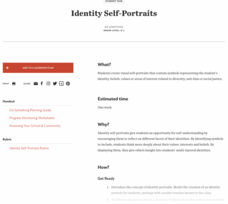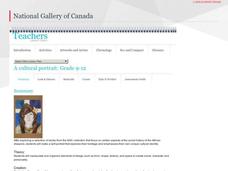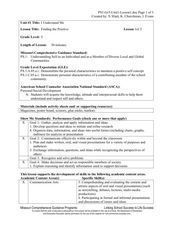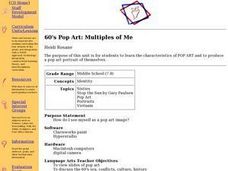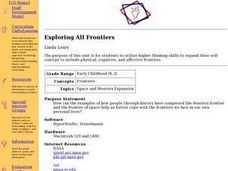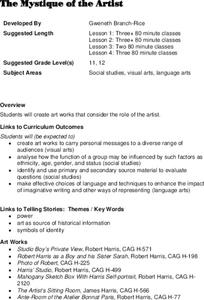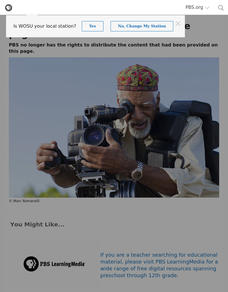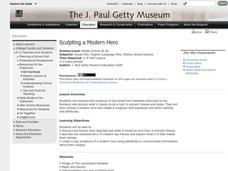Teaching Tolerance
Identity Self-Portraits
What symbols represent you best? Individuals consider how they would draw peers using symbols about their identities with an interview and art activity. After conducting interviews and portraits, the art makes a great centerpiece for...
Teaching Tolerance
Identity Artifacts Museum
Who are you? It's a simple question, but younger learners have the opportunity to express their complex identities by making artifacts that represent parts of their identities. After engaging in the activity, they share who they are with...
Curated OER
I Like Me and I Like You
Learners use the book "I Like Me!" to create a context for investigating self-concept (how one feels about self). They have the objective of realizing their rights and responsibilities. Students work in small groups conducting interviews...
National Museum of the American Indian
Fritz Scholder: A Study Guide
In this engaging activity involving close analysis of abstract expressionist art, your class members will not only discover more about artist Friz Scholder's Native American art, but they will also have the opportunity to consider...
National Gallery of Canada
A Cultural Portrait
Explore heritage and identity through an examination of art and a related project. The featured art, related to the African diaspora, includes several types of art created by different artists. Pupils consider their own backgrounds and...
Curated OER
Finding the Positive
Fifth graders meet the "Famous Artist." They are introduced to the topic of self-concept. Students work in small groups and get organized to create collages. They create a collage that represents characteristics of positive self-concept.
Curated OER
Portraits as Keys to History: Nathaniel Hurd, portraiture, identity
Students view portraits of Nathanial Hurd. They complete a worksheet and identify differences between the portraits. This lesson plan finishes with a visit to the "About Face" exhibit in the Memorial Art Gallery.
Curated OER
Identity of Women in Portraiture
Students look at portraits to learn history. Making connections is done with the identification of details found in the portraits. The gallery depicts the historical times of the Revolutionary War in Colonial America.
Curated OER
60's Pop Art: Multiples of Me
Students discover characteristics of Pop Art through slides and discussion of the 60's era and produce a pop art portrait of themselves using Clarisworks paint program and Hyperstudio.
Curated OER
Visualize Your Future
Learners visualize themselves as a grown person in response to questions asked by the teacher. After visualizing the future students should take 5 - 10 minutes to write down the answers to the Questions About My Dream.
Curated OER
The Real Me!
Fourth graders examine and explain who they are and communicate that person to the viewer through the use of the visual arts. They think about themselves and try to find five things that represent who they are and what they feel is...
Curated OER
Andy Warhol and Silkscreen Pop Art
Students explore art history by researching famous paintings on-line. In this Andy Warhol lesson, students discuss who Warhol was, his impact on popular art and methods of painting. Students examine his use of silk screen printing and...
Curated OER
Getting to Know You
Students participate in tactile and visual exploration. In this tactile and visual exploration lesson, students listen to John Archambault's, Grandmother's Garden, and sing the song, "Friends Are Like Flowers." They participate in ice...
Curated OER
Exploring All Frontiers
Young scholars utilize higher thinking skills to expand their self concept to include physical, cognitive, and affective frontiers. The teacher create activities which allow students to use raw data and primary sources, as well as...
Curated OER
Creative Communication
Students create art works in both visual and written form. They explore how we develop and record our ideas. They create their own sketchbook or journal using simple book making techniques and use the book they created to record ...
Curated OER
The Harlem Renaissance: Black American Traditions
Students examine the time period of the Harlem Renaissance. As a class, they are introduced to five artists and discuss their art and techniques. Using the internet, they also research the philosophers of the time period and how...
Curated OER
The Mystique of the Artist
Learners use mixed media to create personal expression on canvas art supplies bag, design three-dimensional model of their ideal studio space, write character sketch of Robert Harris using images of him, letter he wrote, and his art work...
Curated OER
NATARAJ: SHIVA AS LORD OF THE DANCE
Learners read" the meaning of the Nataraj, explore the various aspects of Hinduism that the Nataraj symbolizes; examine the importance of the samsara, moksha, and consider the Nataraj one of the finest works of art anywhere in the world.
Curated OER
Contemporary: An Alternative Magazine
Students create a magazine that is circulated in an alternative format. They design each issue in the form of a student-created box. They explore issues relating to experiences of young people in different times and places.
Curated OER
Exploring the Roots of Modern Dance in America
Students develop an understanding of how African culture impacted modern dance in the United States.
Curated OER
Sculpting a Modern Hero
Sixth graders examine the sculpture of the Greek hero Herakles (Hercules). In this Ancient History lesson plan, 6th graders discuss how heroes were depicted and what it meant to be a hero in ancient Greece. Students create a...
Curated OER
Home: the Story of Maine "A Love for the Land": Where Are You? Who Are You?
Students investigate their neighborhood both as it is now and as it was 100 years ago. They take a walk around their neighborhood and fill out a worksheet before completing a worksheet.
Curated OER
What is Me?
Students use the internet to research the different meanings of their names. In groups, they discover their astrological sign and share their opinions about whether they believe in them or not. Individually, they use this information...
Curated OER
The Importance of Scribbling and Doodling
Ninth graders discuss what journaling means to them and discovers that it does not always have to be writing. Using the Internet, they research the different types of journaling and chooses one that meets their own style. They make...
